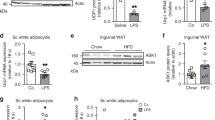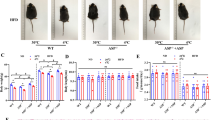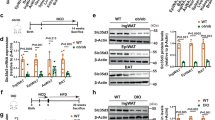Abstract
Objective:
Development of brown-like/beige adipocytes in white adipose tissue (WAT) helps to reduce obesity. Thus we investigated the effects of resveratrol, a dietary polyphenol capable of preventing obesity and related complications in humans and animal models, on brown-like adipocyte formation in inguinal WAT (iWAT).
Methods:
CD1 female mice (5-month old) were fed a high-fat diet with/without 0.1% resveratrol. In addition, primary stromal vascular cells separated from iWAT were subjected to resveratrol treatment. Markers of brown-like (beige) adipogenesis were measured and the involvement of AMP-activated protein kinase (AMPK) α1 was assessed using conditional knockout.
Results:
Resveratrol significantly increased mRNA and/or protein expression of brown adipocyte markers, including uncoupling protein 1 (UCP1), PR domain-containing 16, cell death-inducing DFFA-like effector A, elongation of very long-chain fatty acids protein 3, peroxisome proliferator-activated receptor-γ coactivator 1α, cytochrome c and pyruvate dehydrogenase, in differentiated iWAT stromal vascular cells (SVCs), suggesting that resveratrol induced brown-like adipocyte formation in vitro. Concomitantly, resveratrol markedly enhanced AMPKα1 phosphorylation and differentiated SVC oxygen consumption. Such changes were absent in cells lacking AMPKα1, showing that AMPKα1 is a critical mediator of resveratrol action. Resveratrol also induced beige adipogenesis in vivo along with the appearance of multiocular adipocytes, increased UCP1 expression and enhanced fatty acid oxidation.
Conclusions:
Resveratrol induces brown-like adipocyte formation in iWAT via AMPKα1 activation and suggest that its beneficial antiobesity effects may be partly due to the browning of WAT and, as a consequence, increased oxygen consumption.
This is a preview of subscription content, access via your institution
Access options
Subscribe to this journal
Receive 12 print issues and online access
$259.00 per year
only $21.58 per issue
Buy this article
- Purchase on Springer Link
- Instant access to full article PDF
Prices may be subject to local taxes which are calculated during checkout






Similar content being viewed by others
References
Vazquez-Vela ME, Torres N, Tovar AR . White adipose tissue as endocrine organ and its role in obesity. Arch Med Res 2008; 39: 715–728.
Coelho M, Oliveira T, Fernandes R . Biochemistry of adipose tissue: an endocrine organ. Arch Med Sci 2013; 9: 191–200.
Van Gaal LF, Mertens IL, De Block CE . Mechanisms linking obesity with cardiovascular disease. Nature 2006; 444: 875–880.
Guilherme A, Virbasius JV, Puri V, Czech MP . Adipocyte dysfunctions linking obesity to insulin resistance and type 2 diabetes. Nat Rev Mol Cell Biol 2008; 9: 367–377.
Saito M . Brown adipose tissue as a regulator of energy expenditure and body fat in humans. Diabetes Metab J 2013; 37: 22–29.
Harms M, Seale P . Brown and beige fat: development, function and therapeutic potential. Nat Med 2013; 19: 1252–1263.
Virtanen KA, Lidell ME, Orava J, Heglind M, Westergren R, Niemi T et al. Functional brown adipose tissue in healthy adults. N Engl J Med 2009; 360: 1518–1525.
Wu J, Bostrom P, Sparks LM, Ye L, Choi JH, Giang AH et al. Beige adipocytes are a distinct type of thermogenic fat cell in mouse and human. Cell 2012; 150: 366–376.
Beranger GE, Karbiener M, Barquissau V, Pisani DF, Scheideler M, Langin D et al. In vitro brown and "brite"/"beige" adipogenesis: human cellular models and molecular aspects. Biochim Biophys Acta 2013; 1831: 905–914.
Bartelt A, Heeren J . Adipose tissue browning and metabolic health. Nat Rev Endocrinol 2014; 10: 24–36.
Peschechera A, Eckel J . "Browning" of adipose tissue—regulation and therapeutic perspectives. Arch Physiol Biochem 2013; 119: 151–160.
Park A, Kim WK, Bae KH . Distinction of white, beige and brown adipocytes derived from mesenchymal stem cells. World J Stem Cells 2014; 6: 33–42.
Lo KA, Sun L . Turning WAT into BAT: a review on regulators controlling the browning of white adipocytes. Biosci Rep 2013; 33: 711–719.
Villarroya F, Vidal-Puig A . Beyond the sympathetic tone: the new brown fat activators. Cell Metab 2013; 17: 638–643.
Bonet ML, Oliver P, Palou A . Pharmacological and nutritional agents promoting browning of white adipose tissue. Biochim Biophys Acta 2013; 1831: 969–985.
Carpene C, Gomez-Zorita S, Deleruyelle S, Carpene MA . Novel strategies for preventing diabetes and obesity complications with natural polyphenols. Curr Med Chem 2014; 22: 150–164.
Wang S, Moustaid-Moussa N, Chen L, Mo H, Shastri A, Su R et al. Novel insights of dietary polyphenols and obesity. J Nutr Biochem 2014; 25: 1–18.
Szkudelska K, Szkudelski T . Resveratrol, obesity and diabetes. Eur J Pharmacol 2010; 635: 1–8.
Lam YY, Peterson CM, Ravussin E . Resveratrol vs. calorie restriction: data from rodents to humans. Exp Gerontol 2013; 48: 1018–1024.
Lagouge M, Argmann C, Gerhart-Hines Z, Meziane H, Lerin C, Daussin F et al. Resveratrol improves mitochondrial function and protects against metabolic disease by activating SIRT1 and PGC-1alpha. Cell 2006; 127: 1109–1122.
Um JH, Park SJ, Kang H, Yang S, Foretz M, McBurney MW et al. AMP-activated protein kinase-deficient mice are resistant to the metabolic effects of resveratrol. Diabetes 2010; 59: 554–563.
Timmers S, Konings E, Bilet L, Houtkooper Riekelt H, van de Weijer T, Goossens Gijs H et al. Calorie restriction-like effects of 30 days of resveratrol supplementation on energy metabolism and metabolic profile in obese humans. Cell Metab 2011; 14: 612–622.
Konings E, Timmers S, Boekschoten MV, Goossens GH, Jocken JW, Afman LA et al. The effects of 30 days resveratrol supplementation on adipose tissue morphology and gene expression patterns in obese men. Int J Obesity (Lond) 2014; 38: 470–473.
Mitterberger MC, Zwerschke W . Mechanisms of resveratrol-induced inhibition of clonal expansion and terminal adipogenic differentiation in 3T3-L1 preadipocytes. J Gerontol A Biol Sci Med Sci 2013; 68: 1356–1376.
Rayalam S, Yang JY, Ambati S, Della-Fera MA, Baile CA . Resveratrol induces apoptosis and inhibits adipogenesis in 3T3-L1 adipocytes. Phytother Res 2008; 22: 1367–1371.
Zhang XH, Huang B, Choi SK, Seo JS . Anti-obesity effect of resveratrol-amplified grape skin extracts on 3T3-L1 adipocytes differentiation. Nutr Res Pract 2012; 6: 286–293.
Lasa A, Schweiger M, Kotzbeck P, Churruca I, Simon E, Zechner R et al. Resveratrol regulates lipolysis via adipose triglyceride lipase. J Nutr Biochem 2012; 23: 379–384.
Gomez-Zorita S, Treguer K, Mercader J, Carpene C . Resveratrol directly affects in vitro lipolysis and glucose transport in human fat cells. J Physiol Biochem 2013; 69: 585–593.
Baile CA, Yang JY, Rayalam S, Hartzell DL, Lai CY, Andersen C et al. Effect of resveratrol on fat mobilization. Ann NY Acad Sci 2011; 1215: 40–47.
Mercader J, Palou A, Bonet ML . Resveratrol enhances fatty acid oxidation capacity and reduces resistin and Retinol-Binding Protein 4 expression in white adipocytes. J Nutr Biochem 2011; 22: 828–834.
Daval M, Diot-Dupuy F, Bazin R, Hainault I, Viollet B, Vaulont S et al. Anti-lipolytic action of AMP-activated protein kinase in rodent adipocytes. J Biol Chem 2005; 280: 25250–25257.
Lihn AS, Jessen N, Pedersen SB, Lund S, Richelsen B . AICAR stimulates adiponectin and inhibits cytokines in adipose tissue. Biochem Biophys Res Commun 2004; 316: 853–858.
Stapleton D, Mitchelhill KI, Gao G, Widmer J, Michell BJ, Teh T et al. Mammalian AMP-activated protein kinase subfamily. J Biol Chem 1996; 271: 611–614.
Gaidhu MP, Fediuc S, Ceddia RB . 5-Aminoimidazole-4-carboxamide-1-beta-D-ribofuranoside-induced AMP-activated protein kinase phosphorylation inhibits basal and insulin-stimulated glucose uptake, lipid synthesis, and fatty acid oxidation in isolated rat adipocytes. J Biol Chem 2006; 281: 25956–25964.
Gaidhu MP, Ceddia RB . The role of adenosine monophosphate kinase in remodeling white adipose tissue metabolism. Exerc Sport Sci Rev 2011; 39: 102–108.
Bijland S, Mancini SJ, Salt IP . Role of AMP-activated protein kinase in adipose tissue metabolism and inflammation. Clin Sci (Lond) 2013; 124: 491–507.
Daval M, Foufelle F, Ferré P . Functions of AMP-activated protein kinase in adipose tissue. J Physiol 2006; 574: 55–62.
Duarte LC, Vaanholt LM, Sinclair RE, Gamo Y, Speakman JR . Limits to sustained energy intake XII: is the poor relation between resting metabolic rate and reproductive performance because resting metabolism is not a repeatable trait? J Exp Biol 2010; 213: 278–287.
Speakman JR . Measuring energy metabolism in the mouse - theoretical, practical, and analytical considerations. Front Physiol 2013; 4: 34.
Aune UL, Ruiz L, Kajimura S . Isolation and differentiation of stromal vascular cells to beige/brite cells. J Vis Exp 2013; 28: 50191.
Wang S, Zhou G, Shu G, Wang L, Zhu X, Gao P et al. Glucose utilization, lipid metabolism and bmp-smad signaling pathway of porcine intramuscular preadipocytes compared with subcutaneous preadipocytes. Cell Physiol Biochem 2013; 31: 981–996.
Xue R, Wan Y, Zhang S, Zhang Q, Ye H, Li Y . Role of bone morphogenetic protein 4 in the differentiation of brown fat-like adipocytes. Am J Physiol Endocrinol Metab 2014; 306: E363–E372.
Fu X, Zhao JX, Zhu MJ, Foretz M, Viollet B, Dodson MV et al. AMP-activated protein kinase alpha1 but not alpha2 catalytic subunit potentiates myogenin expression and myogenesis. Mol Cell Biol 2013; 33: 4517–4525.
Diepart C, Verrax J, Calderon PB, Feron O, Jordan BF, Gallez B . Comparison of methods for measuring oxygen consumption in tumor cells in vitro. Anal Biochem 2010; 396: 250–256.
Zhao G, Zhang X, Xu X, Wolin MS, Hintze TH . Depressed modulation of oxygen consumption by endogenous nitric oxide in cardiac muscle from diabetic dogs. Am J Physiol Heart Circ Physiol 2000; 279: H520–H527.
Yang QY, Liang JF, Rogers CJ, Zhao JX, Zhu MJ, Du M . Maternal obesity induces epigenetic modifications to facilitate zfp423 expression and enhance adipogenic differentiation in fetal mice. Diabetes 2013; 62: 3727–3735.
Cardiff RD, Miller CH, Munn RJ . Manual hematoxylin and eosin staining of mouse tissue sections. Cold Spring Harb Protoc 2014; 2014: 655–658.
Chi V, Chandy KG . Immunohistochemistry: paraffin sections using the Vectastain ABC kit from vector labs. J Vis Exp 2007; 8: e308.
Higashida K, Kim SH, Jung SR, Asaka M, Holloszy JO, Han DH . Effects of resveratrol and SIRT1 on PGC-1alpha activity and mitochondrial biogenesis: a reevaluation. PLoS Biol 2013; 11: e1001603.
Mader I, Wabitsch M, Debatin KM, Fischer-Posovszky P, Fulda S . Identification of a novel proapoptotic function of resveratrol in fat cells: SIRT1-independent sensitization to TRAIL-induced apoptosis. FASEB J 2010; 24: 1997–2009.
Fischer-Posovszky P, Kukulus V, Tews D, Unterkircher T, Debatin KM, Fulda S et al. Resveratrol regulates human adipocyte number and function in a Sirt1-dependent manner. Am J Clin Nutr 2010; 92: 5–15.
Baur JA, Pearson KJ, Price NL, Jamieson HA, Lerin C, Kalra A et al. Resveratrol improves health and survival of mice on a high-calorie diet. Nature 2006; 444: 337–342.
Alberdi G, Rodriguez VM, Miranda J, Macarulla MT, Churruca I, Portillo MP . Thermogenesis is involved in the body-fat lowering effects of resveratrol in rats. Food Chem 2013; 141: 1530–1535.
Andrade JM, Frade AC, Guimaraes JB, Freitas KM, Lopes MT, Guimaraes AL et al. Resveratrol increases brown adipose tissue thermogenesis markers by increasing SIRT1 and energy expenditure and decreasing fat accumulation in adipose tissue of mice fed a standard diet. Eur J Nutr 2014; 53: 1503–1510.
Kajimura S, Seale P, Kubota K, Lunsford E, Frangioni JV, Gygi SP et al. Initiation of myoblast to brown fat switch by a PRDM16-C/EBP-beta transcriptional complex. Nature 2009; 460: 1154–1158.
Seale P, Bjork B, Yang W, Kajimura S, Chin S, Kuang S et al. PRDM16 controls a brown fat/skeletal muscle switch. Nature 2008; 454: 961–967.
Ramos-Jimenez A, Hernandez-Torres RP, Torres-Duran PV, Romero-Gonzalez J, Mascher D, Posadas-Romero C et al. The respiratory exchange ratio is associated with fitness indicators both in trained and untrained men: a possible application for people with reduced exercise tolerance. Clin Med Circ Respirat Pulm Med 2008; 2: 1–9.
Price NL, Gomes AP, Ling AJ, Duarte FV, Martin-Montalvo A, North BJ et al. SIRT1 is required for AMPK activation and the beneficial effects of resveratrol on mitochondrial function. Cell Metab 2012; 15: 675–690.
Canto C, Gerhart-Hines Z, Feige JN, Lagouge M, Noriega L, Milne JC et al. AMPK regulates energy expenditure by modulating NAD+ metabolism and SIRT1 activity. Nature 2009; 458: 1056–1060.
Acknowledgements
Special thanks to Joseph Maricelli for his help in the measurement of basal metabolic rate. This work was supported by grants from National Institutes of Health (R01HD067449), the National Natural Science Foundation of China (31372397), the Muscular Dystrophy Association (216602) and the National Science Foundation (1147275). This activity was also funded, in part, with an Emerging Research Issues Internal Competitive Grant from the Agricultural Research Center at Washington State University, College of Agricultural, Human, and Natural Resource Sciences.
Author information
Authors and Affiliations
Corresponding author
Ethics declarations
Competing interests
The authors declare no conflict of interest.
Rights and permissions
About this article
Cite this article
Wang, S., Liang, X., Yang, Q. et al. Resveratrol induces brown-like adipocyte formation in white fat through activation of AMP-activated protein kinase (AMPK) α1. Int J Obes 39, 967–976 (2015). https://doi.org/10.1038/ijo.2015.23
Received:
Revised:
Accepted:
Published:
Issue Date:
DOI: https://doi.org/10.1038/ijo.2015.23
This article is cited by
-
Effects of caffeoylquinic acid analogs derived from aerial parts of Artemisia iwayomogi on adipogenesis
Food Science and Biotechnology (2023)
-
Regenerative Medicine for Polycystic Ovary Syndrome: Stem Cell-Based Therapies and Brown Adipose Tissue Activation
Stem Cell Reviews and Reports (2023)
-
Browning of the white adipose tissue regulation: new insights into nutritional and metabolic relevance in health and diseases
Nutrition & Metabolism (2022)
-
Pharmacological modulation of cytokines correlating neuroinflammatory cascades in epileptogenesis
Molecular Biology Reports (2022)
-
Natural Bioactive Compounds as Potential Browning Agents in White Adipose Tissue
Pharmaceutical Research (2021)



